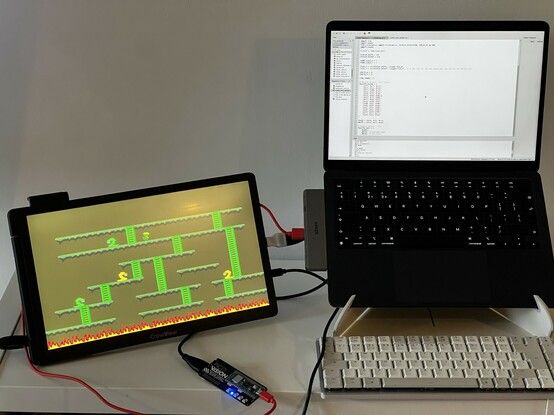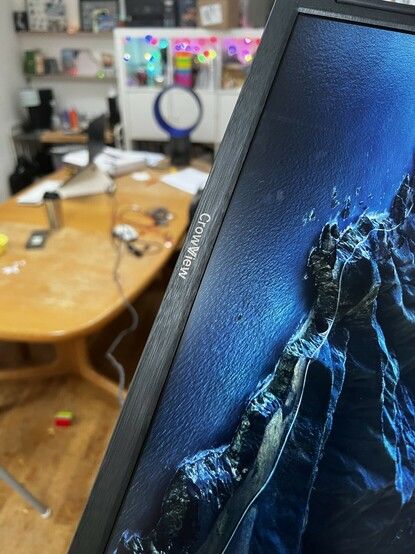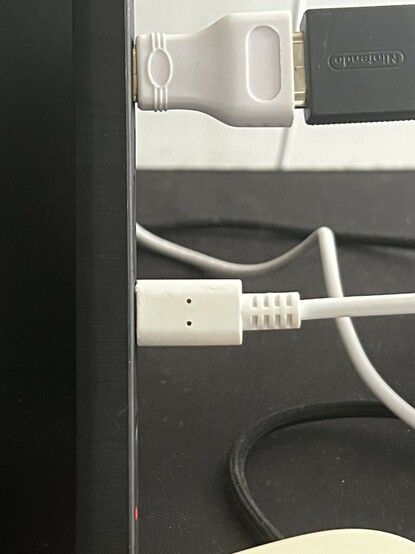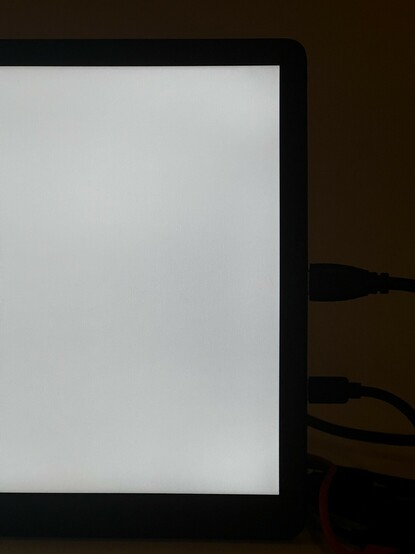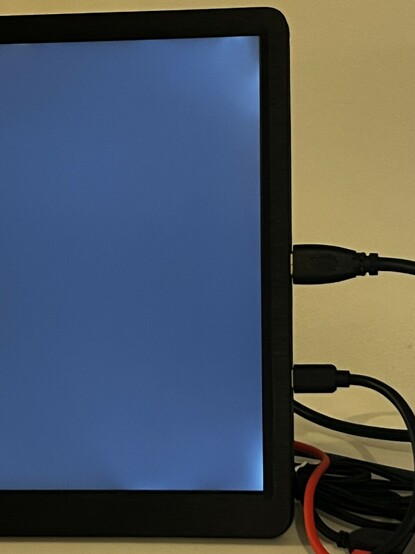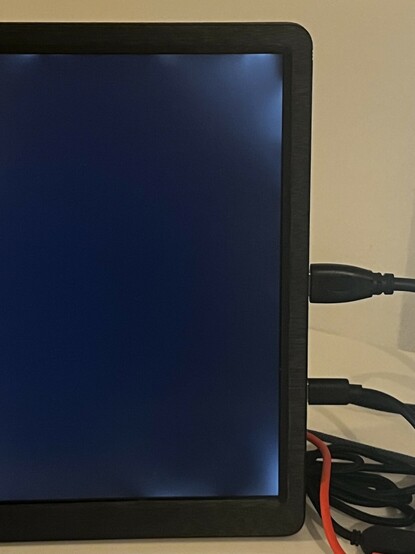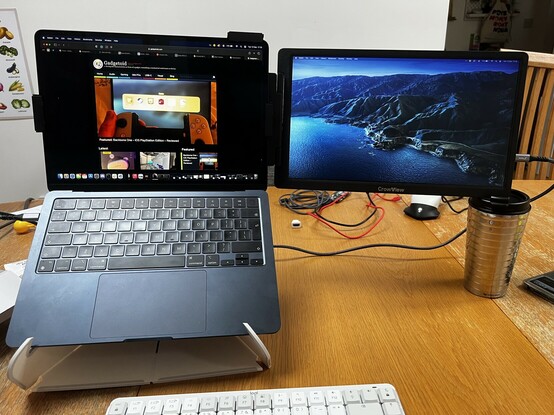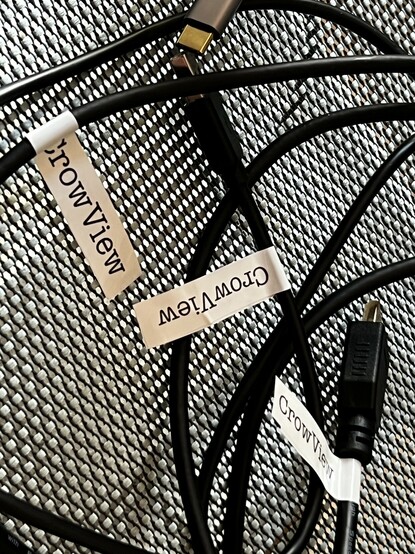Elecrow CrowView – 14” portable monitor – Review
Perhaps best known for their range of maker products, and the Pi-Top-a-like CrowPi, in addition to their PCB prototyping and assembly services Elecrow also dabble in screens of all shapes and sizes. While most of these are bare LCD boards and drivers, or something with a distinctly maker vibe, CrowView is a complete, standalone – and thus much more mainstream appeal – portable monitor.
It was after I had reached out to every portable monitor manufacturer I could find, rather unsuccessfully I might add, that Elecrow popped out of the blue with their CrowView Kickstarter. I couldn’t say “gimme gimme” fast enough. It just so happened that my work on PicoVision – a microcontroller-powered HDMI stick – meant I was using my janky, LCD panel in a laser-cut-case all day, every day for testing.
A display I can grab and prop up in the house for working on stuff that needs HDMI - PicoVision and often Raspberry Pi - is absolutely indispensable!
Okay, before we get into the review let’s put on the brakes and shove the elephant out of the room. My day job, working for maker company Pimoroni, might put me somewhat at odds with Elecrow who, in some respects, might be considered our competitor. I am not, however, fiercely competitive and I prefer to uplift and support others in our industry than try to get ahead. Sheesh- there are even more direct competitors to our business who I would call friends. If anything I might be biassed toward Elecrow… they’ve got some shiny toys! We could be buds, too.
Okay, with that out of the way. What do I think of Elecrow’s portable, 14”, 1080p monitor?
Let’s begin at the end. My original conclusion was going to be “I like it, but the price is a little keen,” but Elecrow have completely undermined this by offering it for $115 which seems much more in line with their competitors pricing on Amazon.
The price feels high because, despite being absolutely perfectly brilliant at what it’s supposed to do, CrowView is decidedly lacking in fit and finish. It’s a cheap, plastic, slightly creaky display that flexes and bends all too easily. Despite being marketed as portable it’s distinctly lacking any kind of hard-cover to protect the screen in transit. To keep it safe in a bag, your best bet is to sandwich it facing your laptop which is a little unnerving.
The USB C ports on the CrowView work for both data and power, so - thanks to SubbyTech’s beefy USB-C cable - I can sit the monitor 5 meters away from my laptop 🤣
Build quality aside the CrowView is functionally pretty awesome. As you’d expect from a modern, portable monitor it can be powered and driven from a single USB Type-C cable making for a very tidy setup and avoiding the need to carry an – why are they always so thick? – HDMI cable.
HDMI works too, or course, via a mini HDMI port that joins the two (power and/or data) USB Type-C ports. It works very well, in fact, and using the CrowView as a standalone HDMI display has been my mainstay during testing.
It’s a good thing it came with a mini HDMI to HDMI cable because using an adapter is… sketchy.
One downside to the ports is that they stick quite awkwardly out of one side. The same, of course, could be said for your laptop so I’m not sure why it bothers me so much on a thin, auxiliary display. I’d almost prefer a little lump on the back that lets the ports escape cleanly out of sight, but the laptop side of things will inevitably mess this up. It’s nothing a silly 180 degree USB and/or mini HDMI adapter couldn’t fix, either way.
Ports aren’t much use without a good display, right? Fortunately CrowView includes an IPS panel that passed any image quality test I could throw at it- chiefly running through gradient banding, contrast, white level and black level tests on lagom.nl.
More surprising than the image tests – which any self respecting IPS panel should pass with flying colours these days – was the latency test. When connected to my M2 MacBook Air via a USB Type-C cable, using the DisplayPort alt mode, it was ever so slightly ahead of the laptops built-in display. This both is and isn’t surprising based on experiences I’ve had with other laptops, but is nonetheless reassuring that CrowView won’t be frustrating to use and could – in a pinch – be absolutely suitable for gaming.
I suppose I shouldn’t be surprised by this - having seen improved frame rates on some laptops when using external displays- but CrowView tracks just slightly ahead of the MacBook Air’s integrated display for latency.
CrowView has an OSD, as you would expect, giving access to image settings, backlight brightness, and – though I couldn’t test it – an intriguing FreeSync toggle. You can even connect multiple sources and switch between them.
On the bad side, my sample of CrowView has abysmal backlight bleed. This is a phenomenon where – on darker colours – the backlight can be seen around the edge of the screen. Generally any backlight bleed is considered unforgivable, though it can often be exaggerated in low light and with full black on the display. I asked Elecrow about it and they claimed to be making the foam behind the LCD panel slightly thicker to get a good seal with the screen bezel. I won’t have a final sample to confirm their changes, but fingers crossed.
Backlight bleed at various shades of grey. During normal use it’s not super visible, but it’s definitely among the worst I’ve seen.
While the backlight bleed was – by a country mile – the worst I’ve seen on any display ever, I was surprised by how little it actually mattered for my use case. Whether or not you’re bothered by it depends entirely on how you use the display, in what lighting conditions and how high you drive the backlight. You probably wont even spot it in my shots of CrowView actually in use.
Propping CrowView up on my desk to use as a monitor for testing PicoVision means I haven’t used it all that much as an auxiliary laptop display. It’s very clearly designed for this purpose, with a large, hinged, clamp setup that folds out from behind it and adds a fair bit of thickness to the stowed display. I am neither combined by nor particularly fond of the idea of clamping a large screen directly to my dainty laptop. It makes me nervous, and the weight of CrowView is easily enough to tip the MacBook Air right over. It works, though, clamping securely in pace and swinging around to provide that much-needed extra display real-estate.
The CrowView from Elecrow clamps perfectly well onto my M2 Air, though it’s a little unnerving to clamp and *quite* heavy. It’s not easy to use - for example - when using a desktop riser to raise the laptop to a comfortable viewing height. Coffee cup to the rescue.
For laptops stood on a desk, CrowView has a fold out support foot that will take at least a little of the display’s weight and avoid things tipping over. You can also use the laptop mount as a stand and run the display in portrait mode – excellent if you’ve got a document or datasheet you need to reference often while working on your primary display – or, as I have been doing, simply prop the CrowView up with that aforementioned foot and use it standalone.
Oh- there are no little finger detents for that fold out foot, so you have to open up the main hinge and push it from the opposite side. This bugs me more than the backlight bleed and I went so far as to try and take the hinge apart and remove all that extra bulk.
I’d gladly take a version of this display without the laptop mount and with a protective cover that doubles as a stand.
I’m the box comes CrowView, a USB a to USB-C power cable, a C to C Power/Data cable for connecting laptops that support it, an HDMI to mini HDMI cable, and a rather uninspiring USB-A power supply that I’d not have missed had they simply left it out. The cables all feel pretty decent and I’m using the HDMI to mini HDMI to go from my HDMI capture device to the display with no issues so far.
CrowView came with a bunch of cables, so I figured I’d fend off the inevitable “oh sheesh what are these for?” by labelling them straight away.
In conclusion CrowView is a cheap and cheerful enclosure around a great little LCD panel with all the connectivity you could need. The build quality leaves something to be desired under any scrutiny, but for $114 it’s adequate. The backlight bleed may be unforgivable for some, but hopefully it’s fixed in the final version. If you’re interested you can grab it direct from Elecrow.
Finally, Elecrow, can you please make a 19” CrowView called Corvid 19? Thanks.
